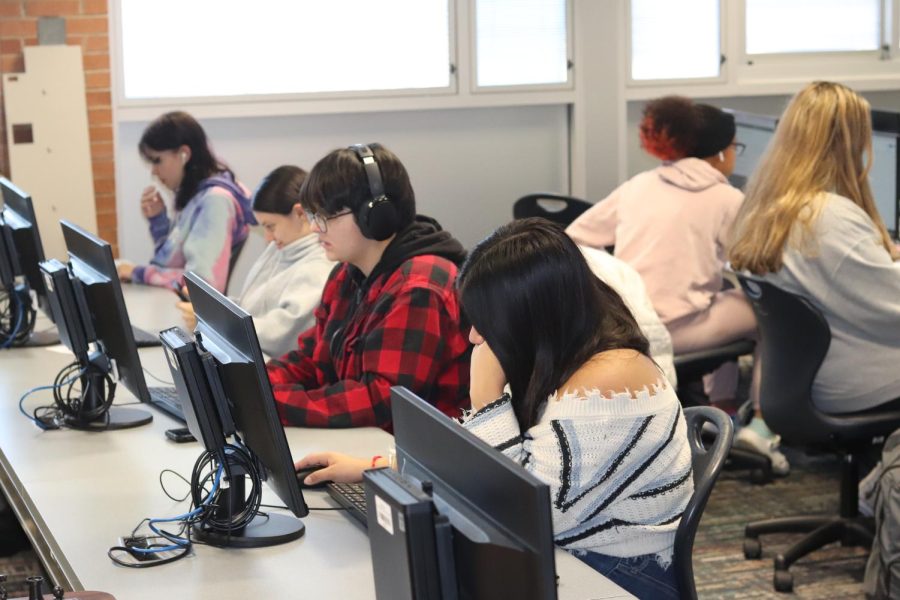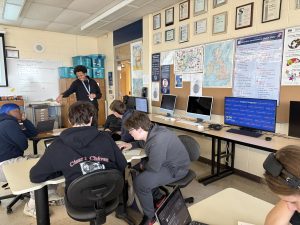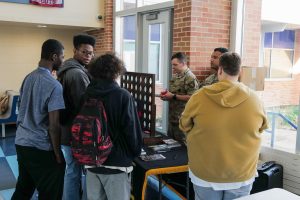Students respond better when teachers actively engage classes
Credit: Gracie Goschke
Students in James Bellwares Career and College Readiness do a worksheet to learn about different organizations they can join after highschool. They looked at the National Guard, Peace Corps, and Teach for America.
January 13, 2023
Imagine sitting in a quiet classroom, where the teacher is sitting at their desk, not engaging in conversations while you sit helplessly at your desk not knowing what to do. This is the reality in many classrooms at Loy Norrix.
Many students at Loy Norrix struggle with negative classroom environments.
A study at Cornell University found that students in classrooms do better when teachers encourage participation, use icebreakers and other methods to make the classroom feel safe, allow everyone to participate and also show respect for everyone’s opinion.
While this is a good standard, this is not accurate for classrooms in all schools.
Sophomore Sam Schnell believes that teachers can have an engaged learning environment.
“It helps when they stand up and teach in front of the class, instead of just handing out assignments for you to do on your own,” said Schnell.
If teachers want to be most effective to their students then they need to create engaging lessons to reach all learning styles.
¨They can explain the stuff instead of just putting it up on the board,¨ said Schnell.
Loy Norrix history teacher James Johnson agrees that teachers switch up their teaching styles to keep their students engaged.
“I think variety is important for engagement, so I try to have a mix of things and not just lecture students every day or give them ‘work’ to do,” said Johnson.
This is true for most students who are hands-on learners, or just can’t comprehend the work without a clear explanation. The unengaging environment of the classroom begins with the teachers.
Students struggling in the classroom environment has been an ongoing problem, but it isn’t always easily noticeable.
Johnson says he often cannot tell when students are struggling, so he tries to check on all of the students throughout the class period.
“I usually start by asking if they are OK. I don’t like to come into a conversation accusing someone of something or assuming things,” said Johnson, “So when a student has their head down or is acting out or something, I try to ask why and then go from there.”
According to the article “Challenging working environments”, school is a very challenging environment for teenagers and a cause of this could be the teacher shortage.
“I think that teachers could take time to help individual students instead of lecturing at the front of the room for an hour,” said junior Sophia Ciokajlo.
Many other Loy Norrix students share similar opinions, including sophomore Luke Fried.
¨I think teachers should try to be more interactive with their students,” Fried said.
However, creating an engaging learning environment isn’t just the job of the teachers. Students also share this responsibility. In many classrooms students are often off-task, distracted by side conversations or phones.
Johnson faces these problems frequently while teaching his classes.
“Honestly, I take it kind of personally sometimes because I work really hard to organize lessons and plan each course to meet the learning objectives,” said Johnson.
Johnson understands that sometimes kids are just having a bad day and that it usually has nothing to do with his teaching, but he still tries to do his best to help.
“I try to be pretty clear about my expectations and why I have them, so I do feel it is rude when students are sitting on their phone or doing other things that interfere with their learning,” Johnson said.
Overall, students and teachers function far better in class when it’s engaging and interesting.











